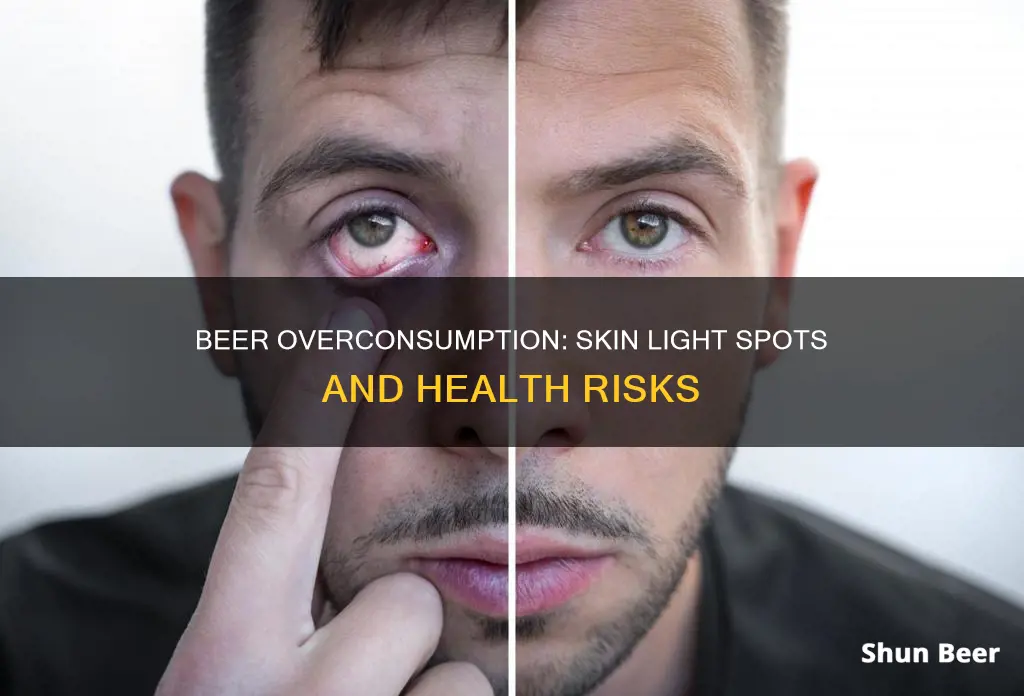
Excessive alcohol consumption can have a range of adverse effects on the skin, including redness, puffiness, acne, and dry skin. While some of these changes may be benign, such as temporary flushing or dry skin, prolonged alcohol abuse can lead to more serious complications, including liver disease and skin cancer. Alcohol can also exacerbate underlying skin conditions such as rosacea, psoriasis, and seborrheic dermatitis. Additionally, alcohol abuse can result in nutritional deficiencies, further contributing to skin problems. To prevent skin issues related to alcohol consumption, the best course of action is to reduce or eliminate alcohol intake.
What You'll Learn

Alcohol and skin cancer
Excessive alcohol consumption is associated with an increased risk of skin cancer. Alcohol is estimated to be responsible for 3.5% of all cancer deaths in the United States. While the link between alcohol and skin cancer is not entirely clear, several studies have found a positive association between alcohol intake and the development of basal cell carcinoma, squamous cell carcinoma, and melanoma. These are the three most common types of skin cancer.
One study found that the risk of basal cell carcinoma increased by 7% and squamous cell carcinoma by 11% for every 10-gram increase in alcohol intake in distilled spirit form (or one standard beer or small glass of wine) each day. Another study found a 20% increase in melanoma in drinkers compared to non-drinkers or occasional drinkers, with a 55% increase in risk for those who drink five beers per day.
There are several proposed mechanisms for how alcohol may contribute to skin cancer:
- Alcohol can interfere with the body's ability to repair DNA damage caused by ultraviolet (UV) light, which is the main factor that increases basal cell and squamous cell carcinoma.
- Alcohol causes the formation of reactive oxygen species, which can damage DNA.
- Alcohol can increase susceptibility to damage from UV light and suppress the immune system.
- Alcohol metabolism produces acetaldehyde, a known carcinogen that can damage DNA.
It is important to note that the association between alcohol and skin cancer may be influenced by other factors, such as sun exposure habits and ethnicity. The American Cancer Society recommends limiting alcohol consumption to one drink per day for women and two drinks per day for men.
Beer and Semaglutide: What You Need to Know
You may want to see also

Alcohol and skin infections
Alcohol abuse is associated with many health issues, including skin changes. As a small, water- and lipid-soluble molecule, alcohol reaches all tissues of the body and affects most vital functions. Skin infections occur more frequently in patients who drink alcohol excessively due to the impairment of the immune system, nutritional deficiencies, and increased trauma.
Bacterial Skin Infections
Bacterial skin infections may lead to septicaemia (spread to the blood). These include Group A and G streptococcus, Staphylococcus aureus, and Corynebacteria, resulting in erythrasma and pitted keratolysis.
Fungal Skin Infections
Fungal skin infections are common but rarely cause sepsis. They include pityriasis versicolor and widespread tinea corporis.
Urticaria (Hives)
Urticaria (hives) may occur within minutes to hours of drinking alcohol and is sometimes due to an allergic reaction. Flushing and overheating after drinking alcohol may also indicate cholinergic urticaria, brought on by heat, exercise, or stress.
Cellulitis
Heavy drinking can make you more likely to get cellulitis, a bacterial skin infection that usually affects your lower legs. It makes the skin there red, swollen, painful, and warm to the touch. The bacteria enter your body through a cut or wound in your skin. The infection is often serious and requires treatment with antibiotics.
Beer Drinking: A Sign of Intelligence or Stupidity?
You may want to see also

Alcohol and skin elasticity
Alcohol abuse has been defined as recurrent alcohol use that impacts work, school, or home life, or that continues despite the problems it has created. Excessive alcohol intake can result in many health problems and is a cause or aggravating factor for several skin conditions.
Alcohol is a diuretic, meaning it pulls water out of your body and can make you dehydrated. This dehydration can cause visible signs of ageing in the skin, such as wrinkles and fine lines. Alcohol also causes blood vessels at the skin's surface to dilate, which can lead to temporary skin flushing and, over time, the bursting of capillaries, creating visible red and purple veins.
Alcohol abuse can also lead to nutritional deficiencies, as it replaces normal food in the diet. This can cause the skin to become dry and lose elasticity. Vitamin A deficiency, for example, results in dry skin and rough follicles. Vitamin C deficiency can cause corkscrew hairs and bleeding in the skin. Zinc deficiency can cause a condition called acquired acrodermatitis enteropathica, with dermatitis around the mouth, hands, feet, and anus.
In addition to the direct effects of alcohol on the skin, heavy drinking can also lead to liver disease, which can cause further skin issues. For example, spider telangiectases, which are dilated blood vessels that radiate out from a central blood vessel, are associated with liver cirrhosis due to elevated oestrogen levels. Chronic alcoholic liver disease may also lead to the reddening of the palms of the hands.
To minimise the impact of alcohol on skin elasticity, it is recommended to reduce alcohol intake, drink water alongside alcoholic beverages, and allow time for the alcohol to leave your system between drinking days.
Beer Drinking Outside Disneyland: What You Need to Know
You may want to see also

Alcohol and skin redness
Alcohol abuse can cause several skin conditions, including acne, cellulitis, dermatitis, eczema, hives, psoriasis, rosacea, and seborrhoeic dermatitis.
Facial flushing, or the "alcohol flush reaction", is a common side effect of drinking alcohol, especially in heavy drinkers. This reaction occurs when the body cannot fully digest alcohol, leading to a buildup of acetaldehyde, a toxic by-product of alcohol breakdown. This buildup can cause a histamine response, resulting in the dilation of facial blood vessels and skin redness or flushing. People of Asian and Jewish descent are more likely to experience this reaction due to a deficiency in the ALDH2 enzyme, which breaks down acetaldehyde.
While facial flushing itself is not harmful, it may indicate an increased risk of other health problems, such as high blood pressure and certain types of cancer, particularly esophageal cancer. Alcohol abuse is also associated with an increased risk of skin cancer, including squamous cell carcinoma, basal cell carcinoma, and melanoma.
To prevent facial flushing, the only effective method is to avoid or limit alcohol consumption. Some medications, such as histamine-2 (H2) blockers and topical creams like brimonidine and oxymetazoline, can help control flushing by reducing facial redness and narrowing blood vessels. However, these treatments do not address the underlying cause of the flushing and may mask important symptoms.
In addition to redness, alcohol can cause other skin issues such as puffiness, bloating, and dark circles under the eyes due to disrupted sleep. Alcohol can also trigger skin conditions like rosacea, leading to redness and small bumps on the face.
Beer and Vitamins: What's the Deal?
You may want to see also

Alcohol and skin conditions
Alcohol abuse can cause many health problems and is a cause or aggravating factor for several skin conditions. Excessive alcohol intake can lead to enlarged blood vessels, resulting in a persistently red face, which is one of the earliest signs of alcohol abuse. Alcohol can also cause transient flushing, particularly in heavy drinkers, due to the release of histamine. This is more common in people of Asian descent due to a mutation in the enzyme that breaks down alcohol.
Alcohol can trigger skin conditions such as rosacea, causing redness and flushing of the face, cheeks, nose, chin, and forehead. It can also increase the risk of developing psoriasis, a condition characterised by dry, itchy patches of skin. Heavy drinking can also make psoriasis more difficult to treat, as some medications are contraindicated in individuals with liver disease or high triglyceride levels caused by excessive alcohol consumption.
Drinking alcohol can also lead to seborrheic dermatitis, resulting in dandruff and itchy, greasy skin patches. Additionally, alcohol can cause skin infections, including bacterial and fungal infections, due to the impairment of the immune system, nutritional deficiencies, and increased trauma. Alcohol abuse is also associated with an increased risk of skin cancer, as it suppresses the immune system, impairs nutrition, and produces reactive free radicals that damage DNA.
To minimise the impact of alcohol on the skin, it is important to drink in moderation, stay hydrated, and maintain a healthy diet.
Beer and Pristiq: What You Need to Know
You may want to see also
Frequently asked questions
No, drinking too much beer does not cause light spots on the skin. However, alcohol abuse can lead to several skin problems, including redness, flushing, reduced skin elasticity, dryness, and acne.
The short-term effects of alcohol on the skin include dehydration, which can cause temporary changes such as dark circles under the eyes, wrinkles, and fine lines. Alcohol can also trigger skin conditions like rosacea, leading to flushing, irritation, and pimples.
Yes, prolonged alcohol consumption can have more serious and long-lasting effects on the skin. It can increase the risk of skin infections, skin cancer, and skin changes due to alcoholic liver disease, such as jaundice and telangiectasia.







